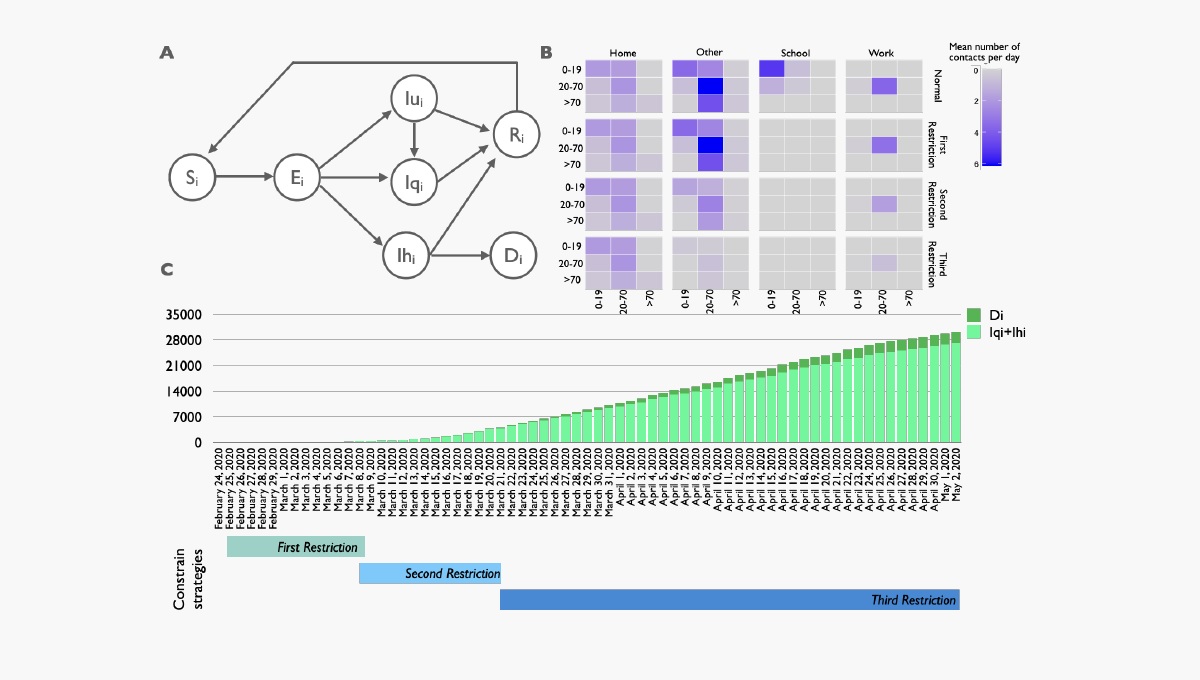Impacts of Reopening Strategies for COVID-19 Epidemic: A Modeling Study in Piedmont Region
Publication date: 22/05/2020 – E&P Code: repo.epiprev.it/1662
Authors: Simone Pernice (SP)1, Paolo Castagno (PC)1, Linda Marcotulli (LM)1, Milena Maria Maule (MMM)2, Lorenzo Richiardi (LR)2, Giovenale Moirano (GM)2, Matteo Sereno (MS)1, Francesaca Cordero (FC)1, Marco Beccuti (MB)1
Abstract: This report is an updated version of repo.epiprev.it/929.
Background: Severe acute respiratory syndrome coronavirus 2 (SARS-COV-2), the causative agent of the coronavirus disease 19 (COVID-19), is a highly transmittable virus.
Since the first person-to-person transmission of SARS-CoV-2 was reported in Italy on February 21-st, 2020, the number of people infected with SARS-COV-2 increased rapidly, mainly in northern Italian regions, including Piedmont. A strict lockdown was imposed on March 21-st until May 4-th when a gradual relaxation of the restrictions started.
In this context, computational models and computer simulations are one of the available research tools that epidemiologists can exploit to understand the spread of the diseases and to evaluate social measures to counteract, mitigate or delay the spread of the epidemic.
Methods. This study presents an extended version of the Susceptible-Exposed-Infected-Removed-Susceptible (SEIRS) model accounting for population age structure. The infectious population is divided into three sub-groups: emph{(i)} undetected infected individuals, emph{(ii)} quarantined infected individuals and emph{(iii)} hospitalized infected individuals. Moreover, the strength of the government restriction measures and the related population response to these are explicitly represented in the model.
Results. The proposed model allows us to investigate different scenarios of the COVID-19 spread in Piedmont and the implementation of different infection-control measures and testing approaches.
The results show that the implemented control measures have proven effective in containing the epidemic, mitigating the potential dangerous impact of a large proportion of undetected cases. We also forecast the optimal combination of individual-level measures and community surveillance to contain the new wave of COVID-19 spread after the re-opening work and social activities.
Conclusion. Our model is an effective tool useful to investigate different scenarios and to inform policy makers about the potential impact of different control strategies. This will be crucial in the upcoming months, when very critical decisions about easing control measures will need to be taken.
Cite as: Simone Pernice, Paolo Castagno, Linda Marcotulli, et al. (2020). Impacts of Reopening Strategies for COVID-19 Epidemic: A Modeling Study in Piedmont Region. E&P Repository https://repo.epiprev.it/1662
Topic: COVID-19
Key words: COVID-19, modelli compartimentali, strategie di controllo,
AVVERTENZA. GLI ARTICOLI PRESENTI NEL REPOSITORY NON SONO SOTTOPOSTI A PEER REVIEW.
Info
Affiliations:
1 Department of Computer, Science, University of Torino, Corso Svizzera 185, 10149, Torino, Italy.
2 Cancer Epidemiology Unit, Department of Medical Sciences, University of Torino – CPO Piemonte, Via Santena 7, 10126, Torino, Italy
Authors’ contributions: PC, SP, GM and LM designed the model and collected the surveillance data. SP and PC performed all the computational analysis. FC and MB draft the paper. MB, FC, MS, LR and MMM supervised the work. MS is the corresponding author. All the authors have read and approved the final manuscript.
Competing interests: The authors declare that they have no competing interests.
Funding disclosure: This work is partially supported by ”Creation of a computational framework to model and study West Nile Disease”project supported by ”Fondazione CRT”.
Ethics committee approval: The study was based on publicly available aggregate data. No Ethics committee approval was necessary.
Copyright: Il detentore del copyright è l’autore/finanziatore, che ha concesso a “E&P Repository” una licenza per rendere pubblico questo preprint. The copyright holder for this preprint is the author/funder, who has granted E&P Repository a license to display the preprint in perpetuity.
Terms of distribution: CC BY

The proposed model is an effective tool useful to investigate different scenarios about the potential impact of different control strategies. This will be crucial in the upcoming months for easing control measures.
References & Citations
Google Scholar

